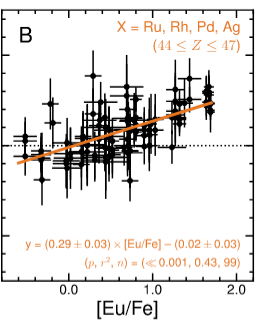Tau.Neutrino said:
1st evidence of nuclear fission in stars hints at elements ‘never produced on Earth’
https://www.livescience.com/space/cosmology/1st-evidence-of-nuclear-fission-in-stars-hints-at-elements-never-produced-on-earth
An analysis of 42 ancient stars in the Milky Way reveals the first hints of nuclear fission in the cosmos, hinting at the existence of elements far heavier than anything found naturally on Earth.
More…
The finding suggests that nature may forge elements with atomic masses greater than 260 — heavier than even those at the edge of the periodic table — before breaking them down again. While simulations of stellar evolution have suggested that this heavy-duty fission is likely to happen, the new research marks the first “direct evidence” of the process.
Wow!
Comparing that with known isotopes in the periodic table.
Uranium 238
Californium <= 258
Nobelium <= 262
The abundances of elements ruthenium, rhodium, palladium, and silver (atomic numbers Z = 44 to 47; mass numbers A = 99 to 110) correlate with those of heavier elements (63 ≤ Z ≤ 78, A > 150). There is no correlation for neighboring elements (34 ≤ Z ≤ 42 and 48 ≤ Z ≤ 62). We interpret this as evidence that fission fragments of transuranic nuclei contribute to the abundances. Our results indicate that neutron-rich nuclei with mass numbers >260 are produced in r-process events.
Article behind a paywall on Science magazine, but free on ArXiv
https://arxiv.org/ftp/arxiv/papers/2312/2312.06844.pdf
Element abundance patterns in stars indicate fission of nuclei heavier than
uranium.
We investigated the r-process using a sample of 42 stars in the Milky Way. We selected stars that
were previously observed to have heavy elements known to be formed by the r-process, with no
evidence of contamination from the s-process.
Element abundances of 31 heavy elements (34 ≤ Z ≤ 90)
We calculated an empirical baseline abundance pattern using the 13 stars with the lowest levels of r-process enhancement. And user this to determine the element excess in the other stars.
The ratio of Europium to Iron is used as a measure of r-process enhancement (because Fe is produced by slow processes and Europium isn’t).
We propose that these element groups (44 ≤ Z ≤ 47 and 63 ≤ Z ≤ 78) were instead produced as fission fragments of transuranic (Z > 92) elements that were synthesized in the r-process but have since decayed. Nucleosynthesis models have predicted that transuranic elements can be produced in r-process events if the ejecta contain very neutron-rich material.
They assume a two neutron star merger as the source of r-process elements. I’m not completely happy with that because such processes are extremely rare compared to high mass supernovas. Also, I don’t see a statement of the statistical significance of the correlation between Europium to Iron and putative fission products. Important to report because oif the scatter in the data.
The following is the graph with the least scatter in the data.

